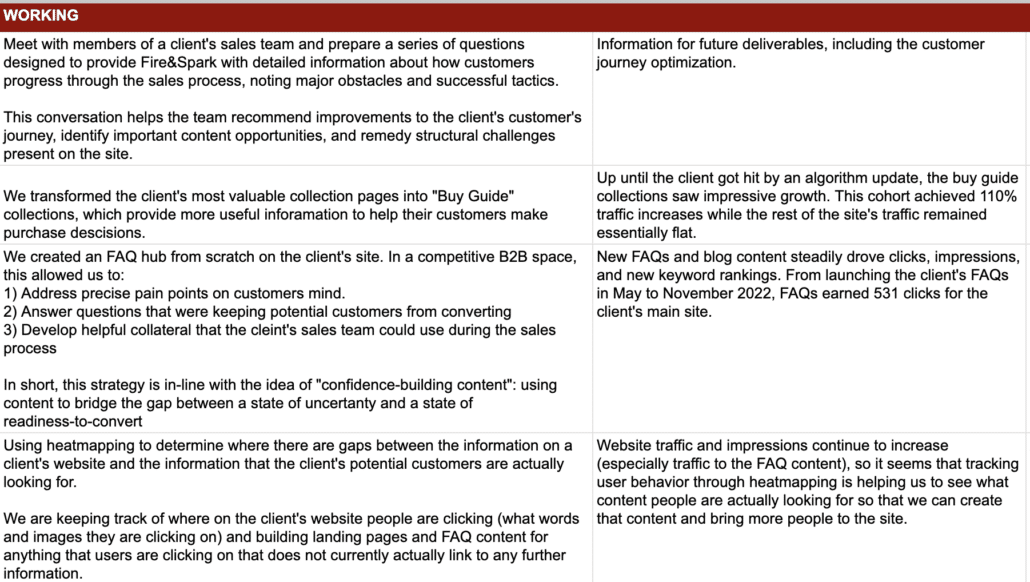There are two ways to approach SEO — or any marketing endeavor, for that matter:
- Follow the best practices.
- Follow what works.
The problem with SEO “best practices”
But wait, aren’t they called “best practices” because they… work the best?
Well, maybe at one point they did. But the truth is that “best practices” often need to change.
If we were still following the same best practices that we were when we started Fire&Spark (or even the same best practices that the industry promoted as recent as a year ago), we would be beating our heads against a wall, wondering whatever happened to those beautiful “up and to the right” graphs that we’d once been drowning in.
Markets are constantly changing. Customers are constantly changing. Products are constantly changing.
Shouldn’t marketing strategies change with them?
Avoiding the trap of Checklist SEO
All too often, we work with clients who spent the last year or longer working with their previous SEO partner on what we call “Checklist SEO”; that is, a looonnngggg list of “best practices” that look impressive, and are backed up by many of the biggest publications in the industry.
We’ve found a number of problems with this.
For starters, there is no such thing as “one-size-fits-all” when it comes to SEO. Differernt industries and niches require the same set of SEO activities. Amazon’s SEO situation and goals are different from Goldman Sachs’, which, in turn, are different from Harvard’s.
Second, and perhaps more importantly, SEO is constantly evolving. I hesitate to put that phrase to paper, because it’s practically a cliche at this point.
How many times have you heard the following?
“Google is constantly updating it’s algorithm.”
“Google is getting smarter.”
“CMS’s are making technical improvements every day.”
The SEO industry can’t stop inundating marketers with sayings like this for one very simple reason: It’s all true.
Why, then, are most SEO specialists pushing the same strategy they were five years ago? Showing clients the same 100-item-long technical SEO checklist? Sending leads the same templated proposals?
The answer is simple: Keeping up with the times is hard work.
What does Evidence-based SEO look like in action?
We have one client we’ve worked with for 4 years. When we started out working with them, we were able to achieve a 40% increase in organic revenue via metadata optimizations and the large-scale creation of hyper-targeted collection pages. As we reached diminishing returns on this tactic, we turned our attention to what was next.
Through our twice-yearly assessment of client results, we identified the new most effective strategies and adjusted our game plan accordingly. Rather than drive the same collection page creation strategy into the ground while ROI evaporated, we were able to use data to fuel a pivot.
Looking across our client base, we were able to identify a big opportunity in the form of transforming their standard collections into comprehensive buying guides. The effectiveness of this strategy for our other clients gave us all the evidence we needed to make an informed adjustment to our long-term client’s SEO plan. By doing so, we’ve been able to grow traffic to these collection-pages-turned-buy-guides by 41%, with increased conversions following in-turn.
In the 4+ years we’ve worked with this brand, we’ve made half-a-dozen such data-driven adjustments to our strategy. In doing so, we ensure that we’re giving our clients the SEO strategy they need today, not the one that was effective 5 years, 1 year, or even 1 month ago.
The future of Evidenced-based SEO at Fire&Spark
Humans are creatures of habit. If we achieve something great once, we will try and press the same buttons over and over again until we can repeat that success.
But the challenges of marketing in 2023 require evolution, adaptation, and, hardest of all, a pea-sized ego.
Over my years, I’ve run literally hundreds of SEO campaigns; each and every one has evolved from the previous, because that’s what the market requires. We’ve learned from our successes and our failures to make sure that we’re giving clients the strategy that they need for their situation at this moment.
To do so, our team runs a biannual assessment of our campaigns: What’s working? What isn’t?

Every 6 months, our team builds out a large library of findings from the specific tactics and strategies on which we’ve been helping our clients execute. We double-down on what’s working, and stop what isn’t generating results.
We create a visual map of our learnings, and adjust our scopes of work to leverage these learnings.
This isn’t Checklist SEO.
It’s Evidence-Based SEO.
It is more cost-effective, data-driven, and reliable for achieving ROI. It gives us the insights that we need to grow, and to bring our clients along with us. It allows the brands we work with to remain one-step ahead of their competition by relying on the best, most up-to-date data available at any given moment.
And it has led us directly to the SEO for Revenue framework.

